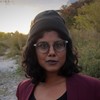Photo courtesy Hot Docs
Advertisement
Kristy Guevara-Flanagan: It's something that has been brewing for a long time for me as a filmmaker and artist; gender has always been central to all of my work. I feel like I've been making the film in my head just by ticking off all dead bodies I've seen throughout the years. And then I started collecting the images and that was what the main bulk of the edit was, was looking for filmsHow did you go about putting together the montage of dead women?
I was definitely interested in the films because the whole narrative tends to revolve around this dead female body and the mystery enshrouding that death or some of the quintessential series like Twin Peaks and True Detective. There was kind of a body of films that that was the heart of the entire narrative and I really wanted to look at those closely. And then simultaneously I started scanning all the TV shows and organizing the material by the way in which they were filmed or found. So I had river bodies and earth bodies and aerial shots of very long, disturbing morgue sections. I wanted there to be a little bit of a chronology so that you build up to the morgue section which is what I always found to be probably the most disturbing aspect.
Advertisement
RIP Laura Palmer. Photo via Wikipedia.
Definitely. The women have a certain physical type, they tend to be attractive and thin and they're just given a lot of screen time whereas the male corpses are not. And in film, you never see dead men. Whether they're in clothes or not, they're always posed in a provocative way and and they're lingered on as well in a cinematic way. Even when they're horrifically violated or mutilated, I feel like there's always a sexual element to the way in which they are seen and that's really disturbing because they're all generally victims of violent crime. Particularly for films and series like Twin Peaks and True Detective, that violation symbolizes the worst thing that can happen in the community and yet there's this tension because we're glorifying their death and violation.Do you think that's a reflection of society?
My kind of interest in this area really grew when I was an editor for the news and there were all these missing girls and they were usually white girls, at least those were the ones that got the media attention. It's just this weird fascination and almost that interest in those kidnappings and often time something really awful had happened to them or they were killed, it regenerates that happening over and over again. What's the worst thing someone can do, is violate a young girl? What's the worst thing that can happen to a community is their virgins are taken away and violated.
Advertisement
It wasn't until I started watching CSI Miami and [CSI] New York that there was more diversity. It sort of harkens back to The Birth of a Nation where it's like the white woman, if you're going to violate the community, you violate her. Ironically, it's not about her, she's a symbol of the community but it's not about her as a human and I think that's something I was trying to get at as well. There's very few women of colour and the few that I did find I put in there.Do you think we value white women more?
Symbolically, yes. And the message there is when a black woman is killed it's not a big deal. And I would say in terms of the real world we hear about that much less, it's less newsworthy attention.
Photo courtesy Hot Docs
I wanted it to really be a very narrow reflection on how these bodies are portrayed and anything else was expanding on the argument but also letting it slip away, my first anger really about these kinds of images. I kept getting it shorter and shorter because it's very hard to watch, I didn't want to add to the glorification and titillation of these kinds of bodies.What were you angry about?
When you start to look at this over and over and over again and see the patterns it's really disturbing. Particularly for me in the morgue sections, there's this whole second violation of these already violated bodies. They're probing them and penetrating them and it's super graphic. And it's about how it's OK to just mutilate women's bodies for some kind of horrific narrative. I think it demonstrates our disregard for women's bodies and for women. You literally just have usually men over these bodies and playing with them.
Advertisement
I didn't need to interview anybody else. Her experience just mirrored all that I was hoping and expecting to get. She is never alive and she's dead on screen for maybe just 35 percent of the film, her body is there, people are gathered around her as she rots naked. The thing I liked about her story too is it just mirrors a young actor's vulnerability in the industry. Not knowing what she was getting into and being asked to do more and more. She was 19 at the time, no acting experience.Did she have any regrets?
It definitely changed her in that it made her realize she did not want to be in front of a camera. And she was sort of willfully naïve about the process and what would happen. You Google her name and all these images of her as a naked dead body come up but she has family now, she's got kids and she doesn't want them to see that.How have people reacted to the movie?
It's really hard to watch is what they always say and that they don't want to watch it again.This interview has been condensed for style and clarity.Follow Manisha Krishnan on Twitter.
